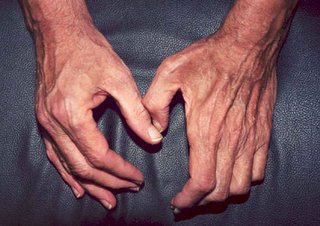Wasting Of The Small Muscles Of The Hands
Examination of hands is very common in PACES setting. You may encounter the hands in locomotor substation or neurology station. There are not many differentials that you need to memorize but you need to have a mind mapping about the approach especially in neurology station.
Related post about PACES hands....
Related post about PACES hands....

1 st case is a 40 years old man with insidious distal weakness for > 12 years. 3 out of his 8 siblings are affected. He has wasting of small muscles of the hands resulting in guttering of the dorsum of the hands. There is generalized areflexia and glove pattern of sensory loss. He came for nerve conduction test which show reduced conduction velocity. The diagnosis is Charcot-Marie-Tooth disease.

2nd case is a middle aged man who had progressive weakness of hands for 10 months. He has wasting and weakness of small muscles of the hands. The hypothenar and thenar eminences are wasted with left more severe than right. There is fasciculation seen and the reflexes are brisk. The sensation is normal. MRI cervical spine and NCS are normal. The diagnosis is motor neuron disease (MND).

3rd case is a 30-year-old lady with a syringomyela developed painless ulcers of the palms and fingers. Other possible skin signs are edema and hyperhydrosis due to interruption of central autonomic pathways.
Confuse? Don't get panic. Just remember several points:
1. We should localize the lesion as LMN i.e. the lesion is at C8-T1 level including the cord, anterior horn cell, nerve roots and peripheral nerves.
2. NMJ is not included because it does not cause wasting. Muscular disorder is not included because it does not usually cause distal weakness.
3. Sensory examination is VERY important in localizing the lesion. For example, if there is sensory loss then MND is excluded from your differential lists.

Please click on the chart for larger figure.
Labels: Neurology


5 Comments:
Thank you eMRCPian.
I would like to add that the commonest causes of small muscles hand wasting are: aging, part of global wasting, rheumatoid arthritis, and cervical spond.myelopathy. Also, always look at the feet and face.
Face:
Looking for ptosis (Horner syndrome in Pancoast tumour)
Tongue for fasculation in MND
face: not only for pancoast...but also for myotonia dystophica,SLE...
Dr. O Amin
had a patient with lmn wasting of upper limbs (with bilateral clawing of her hands)and UMN weakness of lower limbs.sensation,jps was intact. no cerebellar signs. cranial nerves intact.MRI: syringomyelia ...
is it possible with no sensory l
Also look for cervical ribs and palpate pulses (thoracic outlet syndrome) if widespread wasting suggesting proximal C8/T1 radiculopathy or bracial plexopathy.
Post a Comment
<< Home